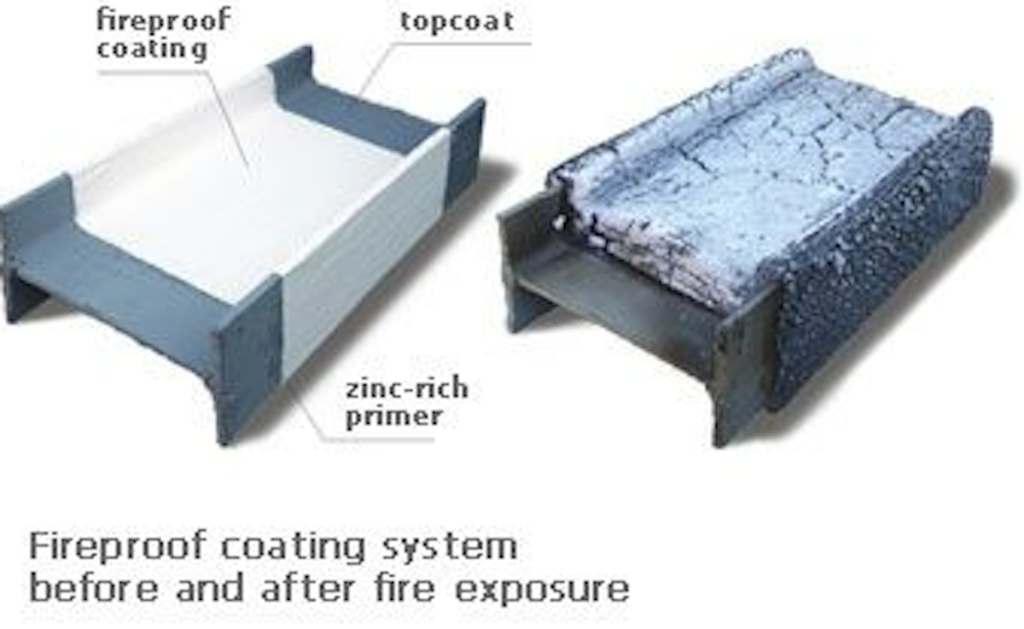What is the purpose of an intumescent Paint?
A type of fire-protection paint, an intumescent paint, is known for its passive role in reacting to high temperatures. When heated, the coating will broaden and form a char-like layer which will shield steel structures from the flames for a predetermined time.
The aim of passive fire safeguarding and fortifying structural steel is to provide those inside the building an opportunity to evacuate. Steel is an incredibly durable and multifaceted building material, however, it starts to lose its rigidity when temperatures reach 550ºC.
Steel protection by way of intumescent paint is typically dense and not transparent, with an exterior finish that resembles a gloss. These coatings are generally applied via airless spray in order to provide a sleek and attractive finish that is still reliable at room temperature. The composition of the coatings commonly consists of organic resin binders like acrylated rubber or epoxy.
Applying the correct thickness of the dry film to achieve the desired fire resistance is essential for a passive fire protection intumescent coating. The wet-film gauge is used to measure the wet film thickness, as a certain wet film thickness will lead to a particular dry film thickness. To get the necessary heat protection, multiple coats may have to be put on to make up the total dry coating thickness.

At temperatures around 250°C, the active ingredients inside the resins will react in a fire, forming a thermally insulating carbonaceous char or foam that can expand up to 50 times the original coating thickness.
The fundamentals of an intumescent fire protection system are composed of an organic adhesive, a carbonific, usually either penta or di-pentaerythritol, a spumific or blowing agent such as melamine or a melamine formaldehyde derivative, an acid catalyst source such as ammonium polyphosphate, and a char reinforcing pigment.
When the heat increases, the binder starts to dissolve and the blowing agent lets off gases, thus creating a regulated growth. Concurrently, the carbon backbone breaks down and the inorganic reinforcing elements come together to form a char solid.
This era of steel-and-glass commercial construction frequently features exposed steelwork as part of the aesthetic. Intumescent coatings make it possible for the steel to be used in the design without requiring the installation of fire protection boards, and still complying with building regulations.
Passive fire protection coatings with intumescent properties supply steel structures with a layer of corrosion defense, and fire defense, as well as a visual appeal if necessary.
In the past decade, a pneumatic pump was the standard for applying intumescent coatings. This pump had an air motor and could reach up to 4-5,000 psi. It necessitated a road compressor of about 150 cfm and was a very weighty machine.
Thanks to advances in intumescent fire protection formulas, the amount of coating needed and the need for extreme pressure application has been decreased. Nowadays, virtually all intumescent coatings can be applied with a smaller, self-contained unit that runs on either a gasoline engine or an electric motor.
In Britain, petrol engines are more prevalently used compared to electric ones since electric power is usually lacking on the construction site during the intumescent application’s beginning stages.
Particular stipulations..
When combusting hydrocarbon fuels such as gas and oil, fires tend to heat up quickly and turbulently. To protect against this phenomenon, a specific passive fire protection paint is necessary. Intumescent coatings have been invented to confront the intense heat of hydrocarbon fires and protect against blast overpressure and jet fire.
For oil and gas projects that take place in extreme environmental conditions, fire protection is needed as well as highly durable coatings. Epoxy intumescent coatings are ideal for these sorts of projects because they provide not only the necessary fire protection, but also blast resistance and the ability to withstand the harshest weather conditions
